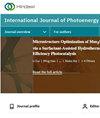一种萤火虫算法和精英蚂蚁系统训练的Elman神经网络用于光伏阵列最ppt算法
IF 2.1
4区 工程技术
Q3 CHEMISTRY, PHYSICAL
引用次数: 0
摘要
本文提出了一种基于萤火虫算法和精英蚂蚁系统训练的Elman神经网络(FA-EAS-ElmanNN)的MPPT算法。首先,通过萤火虫算法(FA)对萤火虫的位置进行随机初始化,同时选取吸引度值较高的萤火虫个体作为最优解;其次,人工释放额外的信息素,提高精英蚂蚁系统的正反馈效应和收敛速度。第三,利用FA和EAS对elmann神经网络的权值和阈值进行更新。同时,利用训练好的ElamnNN获取光伏阵列的最大电压。最后,采用PID控制器和PWM技术对升压变换器的开关时间进行调节。利用MATLAB/Simulink获取辐照度、温度和最大电压数据集,验证了该算法在复杂大气条件下的可靠性和优越性。通过仿真,将MPPT算法与粒子群优化(PSO)、蚁群优化(ACO)、ACO-人工神经网络(ACO- ann)和PSO- rbf神经网络(PSO- rbnfnn)算法的跟踪特性、响应速度和效率进行了对比。与ACO- ann、PSO- rbfnn、PSO和ACO算法相比,FA-EAS-ElmanNN算法的效率分别提高了0.49%、0.58%、1.2%和1.5%,达到99.73%。此外,还建立了实验装置来验证所提出的MPPT算法的跟踪特性。本文章由计算机程序翻译,如有差异,请以英文原文为准。
A Firefly Algorithm and Elite Ant System-Trained Elman Neural Network for MPPT Algorithm of PV Array
This article proposes a novel MPPT algorithm based on the firefly algorithm and elite ant system-trained Elman neural network (FA-EAS-ElmanNN). First, the position of fireflies is randomly initialized by the firefly algorithm (FA), meanwhile the firefly individuals with higher attractiveness degree value are selected as the optimal solution. Second, the extra pheromones are artificially released to boost the positive feedback effect and convergence rate of the elite ant system (EAS). Third, the weight and threshold of the Elman neural network (ElmanNN) are updated by the FA and EAS. Also, the trained ElamnNN is employed to acquire the maximum voltage of the photovoltaic (PV) array. At last, the PID controller and PWM technology are adapted to regulate the switch time of the boost converter. Furthermore, MATLAB/Simulink is adopted to acquire the datasets of irradiance, temperature, and maximum voltage and validate the reliability and superiority of the proposed algorithm under complex atmospheric conditions. The tracking characteristic, response speed, and efficiency of the proposed MPPT algorithm are contrasted with the particle swarm optimization (PSO), ant colony optimization (ACO), ACO-artificial neural network (ACO-ANN), and PSO-RBF neural network (PSO-RBNFNN) algorithm via simulation. The efficiency of the FA-EAS-ElmanNN algorithm is 99.73%, compared with the ACO-ANN, PSO-RBFNN, PSO, and ACO algorithm, which is increased by 0.49%, 0.58%, 1.2% %, and 1.5%, respectively. Additionally, the experimental setup is built to demonstrate the tracking characteristic of the proposed MPPT algorithm.
求助全文
通过发布文献求助,成功后即可免费获取论文全文。
去求助
来源期刊
CiteScore
6.00
自引率
3.10%
发文量
128
审稿时长
3.6 months
期刊介绍:
International Journal of Photoenergy is a peer-reviewed, open access journal that publishes original research articles as well as review articles in all areas of photoenergy. The journal consolidates research activities in photochemistry and solar energy utilization into a single and unique forum for discussing and sharing knowledge.
The journal covers the following topics and applications:
- Photocatalysis
- Photostability and Toxicity of Drugs and UV-Photoprotection
- Solar Energy
- Artificial Light Harvesting Systems
- Photomedicine
- Photo Nanosystems
- Nano Tools for Solar Energy and Photochemistry
- Solar Chemistry
- Photochromism
- Organic Light-Emitting Diodes
- PV Systems
- Nano Structured Solar Cells

 求助内容:
求助内容: 应助结果提醒方式:
应助结果提醒方式:


